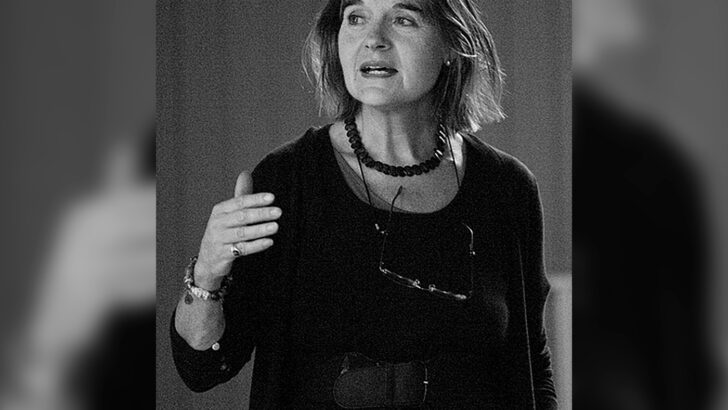Visualising the Celtic Revival: The Arts and Crafts movement in Ireland
selected writings by Nicola Gordon Bowe, edited by Róisín Kennedy (Four Courts Press, €55.00 / £50.00)
The late Nicola Gordon Bowe was one of the most distinguished art historians of her time in Ireland. She was widely admired for her books about the stained glass artists Harry Clarke and Wilhelmina Geddes, which brought these artists into greater prominence after long periods of neglect.
But important as they were, these books represent only a small part of her research interests, as the essays collected in this book demonstrate. They have been selected by the editor from Bowe’s most impressive bibliography of writings (selectively listed at the book’s conclusion).
Of the sixteen essays in this book, only two are focused on stained glass. The other fourteen range widely over artists, industries and issues relating to the Arts and Crafts movement in Ireland, a part of an international trend in art in Britain, America, Scandinavia and the Slavic countries, under the initial influence of the prophetic and practical John Ruskin and William Morris.
Identity
In all of these places the movement was connected with developing notions of identity. Here in Ireland they presented a ‘handmade vision of Ireland’ between 1886 and 1925, that was and remains profoundly moving.
Inevitably some individuals and groups will be familiar: An Túr Gloine, the Dun Emer Guild and the Cuala Press.
So it is the essays on lesser known figures that will stand out for many readers, for it is in these that Bowe’s researches are most penetrating.
The essay on Lord Dunsany as a collector and patron of architecture is fascinating. Dunsany, though his books are still widely read in North America, where they are a part of that world of fantasy and science fiction which has, or perhaps had, a dominant influence there.
Here in Ireland he is now very often seen merely as an eccentric Anglo-Irish man who would bring his own salt with him to dinner parties, a man of fads and fancies galore. But in these pages he emerges I think in something like the figure that impressed so many of his contemporaries, and appears as a man whose ideas and notions were so well informed by the past that they were ahead of their time in the days of the early Free State.
The essay focuses on what he did to restore Dunsany Castle. But it suggests that it is time a proper book was researched and written on the restoration and fitting out of Yeats’ Thoor Ballylee, and its importance in the life and imagination of the poet. Such episodes in the life of artists and writers are often far more revealing than full length biographies, as Bowe shows with Dunsany.
Equally fascinating is the essay on Percy Oswald Reeves, a metal worker and enamellist, whom she calls a “forgotten master of the Irish Arts and Crafts movement”. Here is a new area for collectors, private and public.
One of the essays deals with the furniture of the Arts and Crafts movement in Ireland between 1894 and 1935; again a new area for collectors which is hardly explored.
A theme that runs through all these essays is how the work of these artists found little response in the Irish Free State and later”
Another essay on the same theme harks back to a recent article in these pages about Edward Richards Orpen at Monksgrange, Wexford, and the company he established there between 1927 and 1932. His expert craftsman was a local carpenter who saved both the family from death and the Monskgrange itself from destruction in the troubled times of the Civil War. Orpen’s talents were many and he is an interesting figure now emerging from the fog of neglect.
Two important essays are devoted to the book in the movement, and to Sir Edward Sullivan, a leading expert on the Book of Kells, who was an important patron of well-printed and well-bound books. The heir of all this was Liam Miller at the Dolman Press.
A theme that runs through all these essays is how the work of these artists found little response in the Irish Free State and later. Again and again it is noted how creations were hard to sell, hard to find patrons for, or to have fully appreciated, facing as they did competition from Munich stained glass makers and the dominance of foreign industries.
Appreciation
Now, however, in the light of all this scholarship on the part of Nicola Gordon Bowe, at last a true appreciation can be created, even if it is too late for the artists themselves to benefit.
The skills and achievements of Beatrice Elvery (Lady Glenavy) are described and illustrated in an evocative way. William Orpen felt that her work came to her so easily she did not work at it; but there is great charm and pathos in her pictures.
The fusion of nursery imagery with fanciful Irish details became familiar to many through their diffusion as prints and hangings from the Cuala Press”
Bowe comments that “her works illustrating an attractive Virgin Mary tenderly drying the child Jesus beside a wooden bathtub or ironing his gown beside an open window, were admired as representing ‘sacred interiors’ such as ‘might be seen by the eyes of simple loving country folk in Ireland’ “. The fusion of nursery imagery with fanciful Irish details became familiar to many through their diffusion as prints and hangings from the Cuala Press.
(Oddly, for a book so steeped in research, there is one curious error. We are told that a vase made for Dunsany in 1908 by Gordon Forsyth depicts a galleon on the high seas, with lines attributed by Bowe to the poet John Masefield, “They that go down to the sea in ships, that do business in great waters, these see the works of the Lord and his wonders in the deep”, words which are, of course, from Psalm 107: 23-24: an error Dunsany could not have made, and which must be a bizarre slip by Bowe herself.)


 Peter Costello
Peter Costello Nicola Gordon Bowe
Nicola Gordon Bowe 